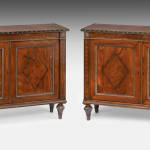Pair of Regency Rosewood and Cut Brass Inlaid Side Cabinets attributed to George Oakley
ENGLAND, CIRCA 1815
90 x 117 x 35 cm
35 ½ x 46 x 13 ¾ in
35 ½ x 46 x 13 ¾ in
7069
Further images
Each cabinet with a brassbound and crossbanded top enhanced with brass patera above a stylised floral frieze, two doors inlaid with diamond motifs and with ormolu mouldings, the pilasters inlaid...
Each cabinet with a brassbound and crossbanded top enhanced with brass patera above a stylised floral frieze, two doors inlaid with diamond motifs and with ormolu mouldings, the pilasters inlaid in brass with a continuous palm leaf motif topped with masks, raised on turned and fluted tapering feet.
The attribution to George Oakley is based on the decorative features which these cabinets share with a documented ebony-inlaid bookcase which was supplied by Oakley to Papworth Hall, Cambridgeshire, for John Madryll Cheere. The Papworth bookcase is decorated with the same distinctive inlaid palm leaf design in the pilasters, and also shares the studded paterae decoration to the frieze.
Other bookcases and cabinets have emerged on the antiques market over the years with similar attributes suggesting that they all emanate from Oakley's workshop. Notably a Regency brass inlaid mahogany dwarf cabinet illustrated in Country Life, 6 June 1985 has a number of similarities to these cabinets, particularly the scrolling foliate brass inlay to the frieze and palm design to the pilasters, along with the ormolu mouldings and feet of similar form. Equally a Regency brass-inlaid ebony open bookcase attributed to Oakley sold at Christie's, London, 10 July 2003, (lot 34).
George Oakley (c. 1765-1841) was apprenticed to William Elliot, 2 St Clements Lane, London and in 1782 was recorded as an 'upholder' trading under his own name until 1789 at the same address. From 1798 he moved to 35 St Paul's Churchyard and had a fabric and wallpaper shop at No. 67 New Bond Street. Oakley was one of the pioneers of ‘buhl’ furniture and furniture in the Grecian taste around the turn of the 19th century. Queen Charlotte granted him a Royal Warrant following a visit in 1799. In 1801 the London correspondent on the ‘Journal de Luxus und der Moden’ (Weimar) wrote 'all people with taste buy their furniture at Oakley's, the most tasteful of the London cabinet makers'. (See M. Jourdain and R. Edwards, Georgian Cabinet Makers, London 1944, p.74). Oakley’s most prestigious commissions included work for the Prince Regent at Carlton House, the Mansion House and the Bank of England, John Madryll Cheere in 1809 for Papworth Hall, Cambridgeshire and James Henry Leigh between 1813-1819 for Stoneleigh Abbey, Warwickshire. He also worked with other prestigious furniture makers Thomas Shackleton and Henry Kettle, the latter having created furniture for Saltram, Devon.
The attribution to George Oakley is based on the decorative features which these cabinets share with a documented ebony-inlaid bookcase which was supplied by Oakley to Papworth Hall, Cambridgeshire, for John Madryll Cheere. The Papworth bookcase is decorated with the same distinctive inlaid palm leaf design in the pilasters, and also shares the studded paterae decoration to the frieze.
Other bookcases and cabinets have emerged on the antiques market over the years with similar attributes suggesting that they all emanate from Oakley's workshop. Notably a Regency brass inlaid mahogany dwarf cabinet illustrated in Country Life, 6 June 1985 has a number of similarities to these cabinets, particularly the scrolling foliate brass inlay to the frieze and palm design to the pilasters, along with the ormolu mouldings and feet of similar form. Equally a Regency brass-inlaid ebony open bookcase attributed to Oakley sold at Christie's, London, 10 July 2003, (lot 34).
George Oakley (c. 1765-1841) was apprenticed to William Elliot, 2 St Clements Lane, London and in 1782 was recorded as an 'upholder' trading under his own name until 1789 at the same address. From 1798 he moved to 35 St Paul's Churchyard and had a fabric and wallpaper shop at No. 67 New Bond Street. Oakley was one of the pioneers of ‘buhl’ furniture and furniture in the Grecian taste around the turn of the 19th century. Queen Charlotte granted him a Royal Warrant following a visit in 1799. In 1801 the London correspondent on the ‘Journal de Luxus und der Moden’ (Weimar) wrote 'all people with taste buy their furniture at Oakley's, the most tasteful of the London cabinet makers'. (See M. Jourdain and R. Edwards, Georgian Cabinet Makers, London 1944, p.74). Oakley’s most prestigious commissions included work for the Prince Regent at Carlton House, the Mansion House and the Bank of England, John Madryll Cheere in 1809 for Papworth Hall, Cambridgeshire and James Henry Leigh between 1813-1819 for Stoneleigh Abbey, Warwickshire. He also worked with other prestigious furniture makers Thomas Shackleton and Henry Kettle, the latter having created furniture for Saltram, Devon.














